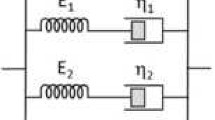Abstract
A method is introduced whereby the complex moduli of viscoelastic materials may be determined in a relatively simple and accurate manner by means of calibration of the measuring system using a specimen of known properties. The appropriate data-reduction equations are presented and use of the method is demonstrated for determination of complex moduli for bovine bones over a four-octave frequency range.
Similar content being viewed by others
Abbreviations
- a′:
-
real part of transmissibility
- a″:
-
imaginary part of transmissibility
- a b :
-
time-dependent base acceleration
- a m :
-
time-dependent mass acceleration
- i :
-
square root of −1
- \(\tilde k\) :
-
general complex spring constant
- k′:
-
real part of general complex spring constant
- k″:
-
imaginary part of general complex spring constant
- v b :
-
voltage output of base accelerometer
- \(\tilde v_m\) :
-
voltage output of mass accelerometer (complex)
- ω:
-
circular frequency in radians per second
- A :
-
cross-sectional area of specimen
- \(\tilde A_B\) :
-
complex acceleration of base
- \(\tilde A_M\) :
-
complex acceleration of mass
- \(\tilde E\) :
-
general complex viscoelastic modulus
- \(\tilde F\) :
-
complex driving-point force
- L :
-
length of specimen
- M :
-
mass present in system
- \(\tilde TR_E\) :
-
complex transmissibility of electrical and extraneous components of system
- \(\tilde U\) :
-
complex displacement of mass
- V :
-
base (driving-point) velocity
- Y :
-
displacement of base
- \(\tilde Z\) :
-
complex driving-point impedance
- Z′:
-
real part of driving-point impedance
- Z″:
-
imaginary part of driving-point impedance
References
Ferry, J. D., Viscoelastic Properties of Polymers, John Wiley, NY (1961).
Snowdon, J. C., Vibration and Shock in Damped Mechanical Systems, John Wiley, NY (1968).
Lazan, B. J., Damping of Materials and Members in Structural Mechanics, Pergamon Press, NY (1958).
Colloquium on Mechanical Impedance Methods for Mechanical Vibration, ASME Publication (1958).
Norris, D. M. andYoung, W., “Complex-modulus Measurement by Longitudinal Vibration Testing,”Experimental Mechanics,10 (2),93–96 (1970).
Author information
Authors and Affiliations
Rights and permissions
About this article
Cite this article
Laird, G.W., Kingsbury, H.B. A method of determining complex moduli of viscoelastic materials. Experimental Mechanics 13, 126–131 (1973). https://doi.org/10.1007/BF02323970
Issue Date:
DOI: https://doi.org/10.1007/BF02323970




